
Portobelo is 25 miles NE of the Colon entrance to the Panama Canal
|
Caribbean Landfalls SW Carib Pages Related Pages Panama NewslettersSW Carib Flora/Fauna |
Portobelo
 Portobelo is 25 miles NE of the Colon entrance to the Panama Canal |
Language: Spanish. This is a city on the Northern coast of Panama, between
the San Blas Islands and the Panama Canal.
Population: Less than 4,000
Money: The good old US dollar (written as "B's", not "$'s,"
because they're still referred to as Balboas). The coins are partially normal US coinage,
or else of the same size but with Panamanian markings.
Landscape: Second-growth tropical forest of mango, sicropia, papaya,
palms and bananas. The beaches are of black sand.
Visited: February 26 - March 1, 2003
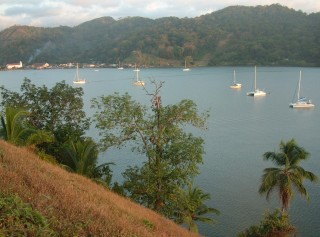 Portobelo in the background. Ocelot is on the far right. |
History: Because of the
beauty of its natural harbor, this sleepy little town was first given the name
"Puerto Bello" (Beautiful Port) by Christopher Columbus in 1502. Over
time, it was shortened to Portobelo.
In 1586, when Portobelo
was still a tiny settlement of about 10 houses, Juan Bautista
Antonelli, known for designing fortresses, was sent there to examine the harbor.
When he noted how protected the town was due to the long harbor, King Felipe II
ordered Portobelo colonized and Nombre de Dios abandoned. It took a while for
people to move, despite the order, and wasn't until the 1596 attack on Nombre de
Dios that a notable flow of people moved to Portobelo. Between the years of 1597
and 1600 was the biggest transfer time of people from Nombre de Dios, and also
the time that the first two forts were built to protect the growing town. In the
years that followed, these initial forts were reinforced, and more built.
Despite these protective barriers, however, buccaneers and the English navy
invaded Portobelo many times to get the silver that came through the port on its
way to Spain from inland.
Not all the
invasions were because of superior numbers or tactics, however. In 1679, the
crews of two ships, 200 men in all, landed three-nights-walk away from Portobelo,
and marched across the land in the cover of darkness. A farmer on the outskirts
of the town saw them and ran to tell the rest of the town. Unaware of the small
numbers of the invaders, the inhabitants fled. Dreading that they would return
with greater numbers, the pirates spent two days of terror in the town,
plundering what was to be taken, until their ships were able to collect them
again. In time, the citizens of Portobelo returned. Today, it is a sleepy
village, rich in history, with a magnificent natural harbor.
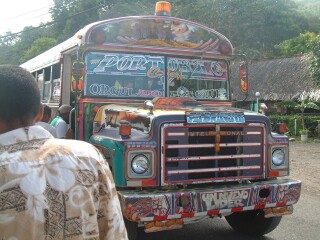 The local busses are magnificently painted |
(Amanda age 13) Portobelo is a
cute little normal town, basically. Well, a cute little town with about five
forts guarding it. The night we arrived there, after a six-hour sail from
San Blas, we dropped the dinghy and went across to see the forts
on the other side of the bay from town. I probably would have spent a lot more time
walking around and exploring them, but the sun was going down and the bugs were coming out. I,
with my sweet blood, decided I'd rather not spend another night with a gazillion
bug bites.
Surprisingly, most
of the forts and some really old buildings in the town are made largely out of
coral. This saddened us, as they renewed the large museum house in the town, and
they went and harvested more coral to make it look authentic. The amount of
coral that they took from the neighboring reefs would take about a hundred years
to grow back.
 Typical Batido (blended up fruit) stand |
Speaking about
reefs, the area around Portobelo is known for shipwrecks and good
snorkeling/diving. Chris really really wanted us to go check out some dive shops
near by, but we didn't get around to it. In fact, I don't think we've even
snorkeled since the San Blas.
We were in
Portobelo for the beginning of Panama's Carnival, and we were dreading the loud
music at midnight that we had gotten from Grenada. Surprisingly, we only had a
little music one night, and I don't think it would have woken anyone up. We went
ashore to see what was happening, and the answer was pretty much nothing. There
were a few guys dressed up in rags and such, but all the music was coming from
the bars, and everyone else was just sitting around in the plaza, drinking and
talking. A bit of a disappointment, but at least we could sleep!
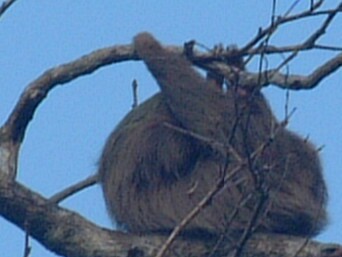 Slothfully hanging around with its head hidden |
(Chris age 16) Portobello
didn't make much of an impression on me, it struck me as being like just about
any other small town on the waterfront. The main thing that struck me about it
was the number and size of the forts guarding it. Considering all the weaponry
the place could have mounted, it should have been almost untouchable. Beyond an
interesting history, however, I can't say I felt much one way or the other
concerning Portobelo.
The forest around
Portobello was an entirely different story, however. Around the small town,
rainforest held sway with almost no sign of human habitation. As on the Rio
Diablo in the San Blas, we took our dinghy and
motored up a river coming out of the forest. The forest closed in around us,
cutting out all human sounds except those we made ourselves. The greenery of the
jungle, highlighted here and there with flowers or fruits, greeted our eyes. The
refreshing scent of fresh water and the forest was relaxing. Birds, most of whom
were out of sight, made bright music, mixed with the sounds of the water and the
occasional call of a distant monkey.
The real treat of
the river, however, was a sloth in a tree. It was clearly visible from the
river, and (of course) held still long enough for us to get a good look at it.
It was hanging curled up when we went by it the first time, and actually moved
(hanging from the bottom of the branch) to another branch as we came back.
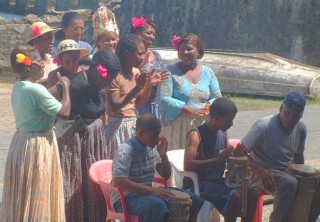 A Portobelo Carnival dance performance |
(Jon) Portobello was supposed to be just an overnight stop to break up the sail from the San Blas to the Canal, but it was such a cute town that we stayed a while. The sail itself was delightful, with the autopilot finally condescending to do most of the work, and Ocelot scooting past several other boats as we close reached to Isla Grande. When we heard that there was effectively no Carnival in Colon but that there would be some low-key celebrations in Portobelo, we thought we'd check them out. But probably the highlight for me was exploring the town, the many forts (many boats get "forted out" but I haven't yet), and exploring up the river. Apparently, the forts used to be even more impressive, but much of their stonework went into building the long breakwaters for the Canal.
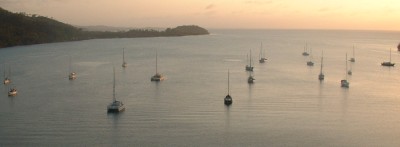 Sunset over the anchorage from Fort San Fernando |
(Sue) This was a surprisingly beautiful anchorage, one we had by-passed in 1988. I continued my sporadic birding here, though I was hindered without a true Birds of Panama guide. Ashore we were befriended by ex-cruisers who now live in the town for 6 months a year, offering a dinghy dock, assistance for cruisers, and a fascinating collection of doubloons, reales, and other old Spanish coins, plus photos and small relics from Portobello's past. I think with the exploration of two of the three remaining forts, I can say I've about had it with Caribbean forts! They do make great platforms for sightseeing and birding, though.
Top Level: Home | Destinations | Cruising Info | Underwater | Boat Guests | Ocelot | Sue | Jon | Amanda | Chris | Site Map | Make a Comment
|
If our information is useful, you can help by making a donation |
Copyright © 2000‑ Contact: Jon and Sue Hacking -- HackingFamily.com, svOcelot.com. All rights reserved.